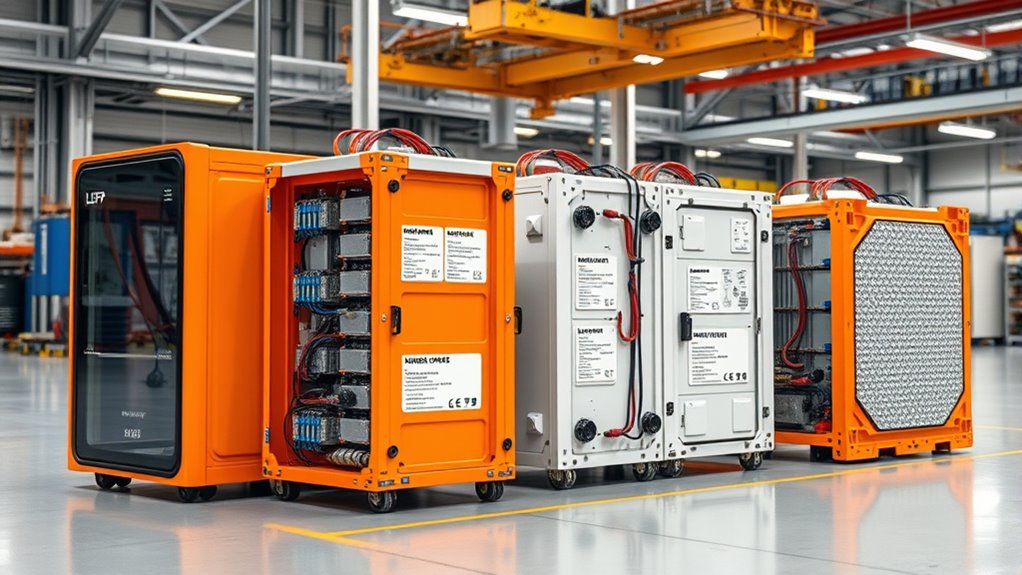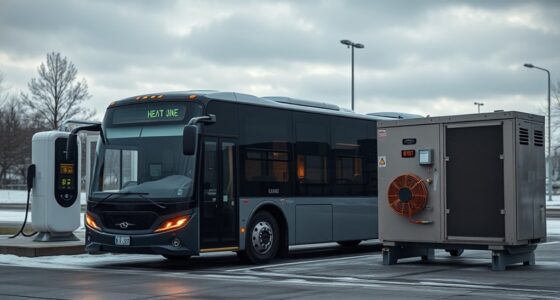When choosing bus batteries, you’ll find LFP batteries offer exceptional safety, longer lifespan, and cost savings over time, though they have lower energy density. NMC4 batteries balance performance with affordability, providing higher energy density for longer range. LTO batteries excel in rapid charging and high cycle life but come with higher upfront costs and lower energy density. Emerging chemistries, like solid-state, promise even better longevity and safety—exploring these options helps you find the best fit for your operational needs.
Key Takeaways
- LFP batteries offer longer lifespan and superior safety, making them cost-effective over the long term despite higher initial costs.
- NMC4 batteries provide higher energy density, enabling longer ranges with moderate cycle life and performance.
- LTO batteries excel in rapid charging and high cycle life but have lower energy density, suitable for short-range or high-turnaround routes.
- Emerging chemistries like solid-state batteries promise enhanced safety, higher energy density, and longer lifespan, potentially transforming bus applications.
- Choice depends on operational priorities such as range, charging speed, safety, and total cost of ownership.

Are you wondering how to choose the best bus battery for your fleet? When evaluating different options, two critical factors come into play: battery lifespan and cost efficiency. These elements come into focus because they determine not only how long your batteries will serve reliably but also how much you spend over their operational life. Understanding the strengths and weaknesses of various chemistries can help you make an informed decision that balances upfront costs with long-term performance.
Lithium iron phosphate (LFP) batteries are known for their exceptional safety and stability. Their longer battery lifespan means fewer replacements and less maintenance over time, which boosts overall cost efficiency. They tend to have a lower cycle degradation rate, allowing you to get more charge-and-discharge cycles out of each battery. Although their initial purchase price might be higher than some alternatives, the extended durability and reduced maintenance costs mean they often pay for themselves in the long run. If your fleet requires consistent, dependable operation with minimal downtime, LFP batteries could be a smart choice.
LFP batteries offer longer lifespan, enhanced safety, and reduced maintenance, making them a cost-effective choice for reliable bus operations.
NMC4 batteries, a variation of lithium nickel manganese cobalt oxide, strike a balance between energy density and cost. They typically offer a good mix of affordability and performance, making them attractive for many bus operators. Their battery lifespan is solid, though slightly shorter than LFP, but their higher energy density allows for longer driving ranges without increasing size or weight. This can translate into better cost efficiency if your routes demand longer distances. However, NMC4 batteries may require more careful thermal management and maintenance to maximize their lifespan, which could influence overall operational costs.
LTO batteries, or lithium titanate oxide, excel in rapid charging capabilities and high cycle life. Their battery lifespan far surpasses many other chemistries, enabling thousands of cycles with minimal capacity loss. This longevity can considerably improve cost efficiency, especially for fleets that need quick turnaround times and frequent charging. However, LTO batteries tend to have higher upfront costs, and their lower energy density can limit driving range. They are ideal for short-range buses or applications where quick charging and durability outweigh initial investment concerns.
Emerging chemistries, such as solid-state batteries or other innovative designs, promise improvements in safety, energy density, and lifespan. While still in development or early deployment stages, these technologies could revolutionize bus energy storage, offering even better cost efficiency and longer lifespan. Keep an eye on these advancements, as they might soon provide options that outperform current chemistries in both longevity and cost savings.
Choosing the right bus battery involves weighing your operational needs against these factors. Prioritize battery lifespan to reduce replacement costs and enhance reliability, and consider how initial investment aligns with long-term savings. By understanding the characteristics of each chemistry, you can select a battery that offers the best balance of durability and cost efficiency for your fleet’s specific needs. Additionally, reliable safety, which is crucial for fleet operations, depends heavily on the chemistry you choose.
Frequently Asked Questions
How Do Battery Recycling Processes Differ Among Chemistries?
You’ll find that recycling techniques vary considerably among chemistries. For LFP batteries, material recovery focuses on cathode components with less hazardous waste. NMC4 batteries require more complex processes to extract valuable metals like nickel and cobalt. LTO batteries are often less recycled due to their longevity, but when done, processes target lithium recovery. Emerging chemistries may need innovative recycling methods to efficiently recover materials, ensuring sustainable reuse.
What Are the Safety Considerations for Each Battery Type?
Imagine a bus operator prioritizing safety; you should consider each chemistry’s fire risks and thermal management. LFP batteries have lower fire risks and benefit from simple thermal strategies, while NMC4 batteries need advanced cooling to prevent thermal runaway. LTO batteries are safer but require careful handling. Always implement robust thermal management strategies, like active cooling, and monitor battery health to minimize fire hazards across all chemistries.
How Do Operating Temperatures Affect Battery Performance?
You’ll notice that operating temperatures markedly impact battery performance. If temperatures fall outside ideal ranges, it affects thermal stability and reduces efficiency. High temperatures can cause overheating, degrading cell chemistry and risking safety, while low temperatures impair chemical reactions, lowering capacity and power output. Choosing batteries with good temperature resilience ensures consistent performance and longevity, especially in varying climates. Maintaining proper thermal management helps prevent damage and keeps your bus batteries operating reliably.
What Are the Cost Differences Over the Battery Lifespan?
Imagine choosing a bus battery with a clear cost analysis and lifespan valuation. LFP batteries typically cost less upfront and last longer, reducing total ownership costs over time. In contrast, NMC4 batteries may have higher initial prices but offer better energy density. LTO batteries might be more expensive initially but excel in durability. Your decision hinges on balancing purchase price, longevity, and operational savings.
How Do Emerging Chemistries Compare in Scalability and Availability?
Emerging chemistries face significant scalability challenges due to limited material availability and production capacity. You might find that sourcing rare or novel materials can slow down large-scale deployment, impacting your ability to meet demand. While these new chemistries show promise for performance, overcoming material supply chain issues is vital for widespread adoption. You’ll need to closely monitor developments and establish reliable supply chains to guarantee successful scaling.
Conclusion
When choosing a bus battery, don’t overlook the importance of safety and longevity. While some chemistries like LFP might seem less powerful initially, they often offer better overall durability and lower thermal risks. This means fewer replacements and safer operation in the long run. So, even if the upfront cost is higher, investing in a reliable chemistry like LFP can save you money and stress over time—making it the smarter choice for your fleet.









